
Eco Art in Textiles: Liz Burow’s Landscape-Inspired Creations
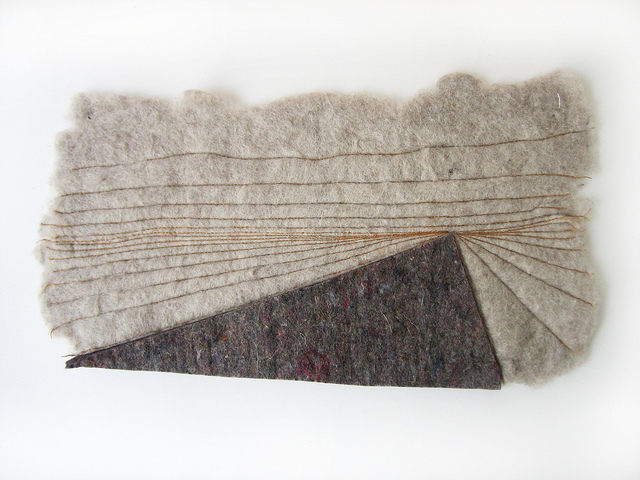
Prairie Scene- Golden Perspective (01)
Dimensions: 9”x17”
Materials: Handmade wool felt, industrial felt, upholstery thread, machine sewn
I can’t think of a more perfect time of year to feature the landscape fabric and quilt artist Liz Burow than at this moment when summer is abruptly shifting and transforming itself into fall. Just like the cycle of the four seasons, Burow’s textiles capture an in-between, unfastened environment of transition and movement.
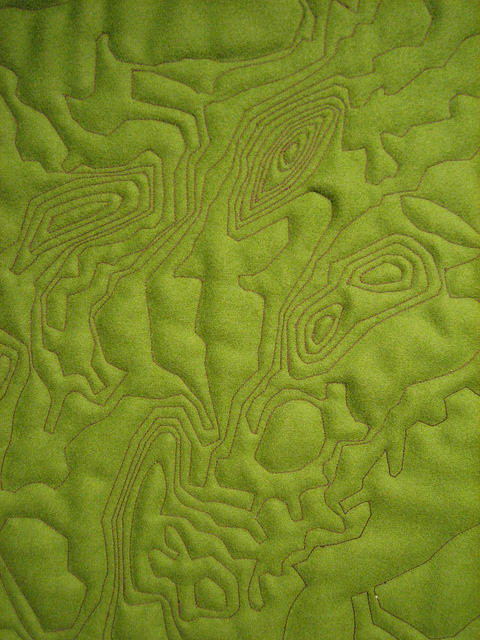
Prospect Park (Green)Topo Quilt
Dimensions: 22”x40”
Materials: Wool and Polyester felt, batting, upholstery thread, machine sewn
Eco Chick: Your artist statement describes how the “Topo-Quilts and Ivy Walls transform our wild landscape into interior décor.” What does that domesticating process mean to you? It seems like there are several steps of abstraction taking place since your textiles render a cartographic and architectural impression of nature (maps, blueprints, and urban plans) rather than a direct visualization of place.
Liz Burow: Domestication: My work is a critique of our efforts to domesticate our landscape and to use motifs from our landscape as domestic ornament. Rather then drawing inspiration from pastoral scenes for inspiration, I’m interested in urban conditions, cars, roads, infrastructure, transportation and mobility, and how these conditions are a part of our aesthetic lives. We live in a very controlled and domesticated environment, yet at times life can feel like complete chaos. My work uses the city as inspiration and the work plays with the idea of control and chaos, natural and artificial, disorder and pattern, plainness and ornament, pastoral and urban. Imagery, patterns, colors and textures typically ignored as an aesthetic are instead enhanced and abstracted and turned into patterns and items for the home. By working with textiles and clothing, and techniques like sewing, quilting and felting the work it is more approachable by being more ordinary and familiar as well as useful.
Abstraction: I come from the architecture profession, where we are trained to make drawings to describe a space that does not yet exist and how to build it. The outcome of the architecture design process is a series of highly detailed standardized drawings made up of many lines, textures, symbols, and abbreviations. The drawings and 3D visualizations may look confusing, but the advantage of this system is that each consultant and builder can extract what meaning or information they need, based on their specialty or expertise. No one reads the drawing in the same way for the same reasons. I think this way of thinking and working has great influence on my artwork. Pictorial and figurative representations of space don’t leave much room for interpretation. I want people to be able to take from the information what they find useful, what they find meaningful.
I don’t start with the idea of a direct visualization of a space and then reduce it to an abstraction. I’ve been trained to see the world through abstractions and am able to visualize a place from these bits and pieces. So, I feel like that is what my art can do too. I like to assemble the sense of a place, or an urban condition through select form, textures, symbols, line work, in order to capture feeling or attitude.
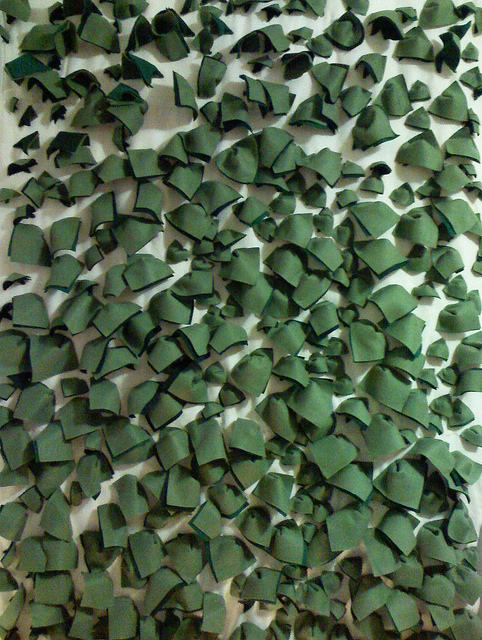
Ivy Felt Wall
Dimensions: 72”x 96”
Materials: Polyester felt, batting, muslin, upholstery thread, hand stitched and machine sewn.
EC: How do you conceive of the relationship between our bodies and the environment in your textiles? What is the place of gender in this relationship?
LB: I think about the human scale and the human experience within the city a lot. For example, a portion of my work is about spaces and landscapes made for people, and spaces and landscapes made for cars. They are two very different scales, and in urban planning and city dwelling, the person and the car are often in competition with each other. This can be seen in the Car Scene series.
I’m interested in fashion and culture as they relate to identity and territory and the boundaries of people as they relate to their environment. These relationships are critiqued by playing with human scale verses an environmental scale, the individual versus the collective. This can be seen in the Ivy League wall.
While I’m working the materials and techniques typically associated with ‘women’s work’, I tend to work with textiles because their properties are aligned with the themes I am trying to address. I’m interested in textiles as material we use to cover ourselves with, but also as a way to express the landscape and environment. Textiles are pliable, conforming, soft to the touch and easily mobile. They are in part are defined by their context- Textiles can be used as body covering or decoration, shelter, container, space divider, or as a ritual object.
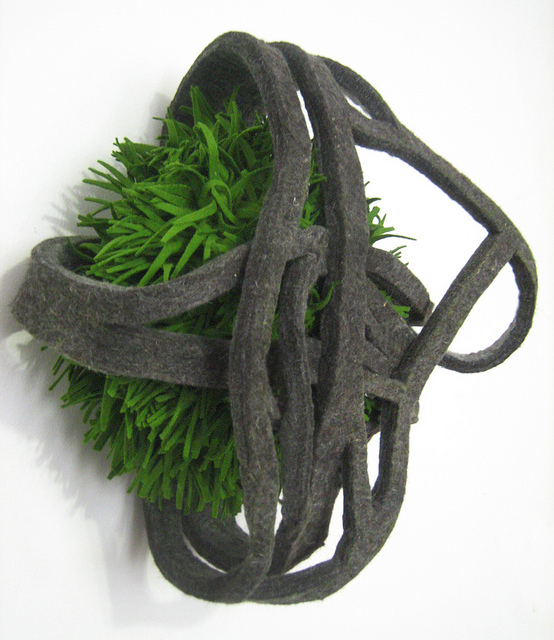
Wall Brooches: GreenInterchange
Dimensions: 20″x 20″x 6″
Materials: Industrial felt, wool felt, upholstery thread, hand stitched
EC: Several of your artworks, such as Car Scenes, have explored the relationship between constructed and wild environments. Your scenes not only define environments, but seem to take us on journeys moving through space (walking, driving, and bicycling) as well as the transitions of borders and frontiers. Could you please comment on this impression of journeying through an environment?
LB: Systems, objects and services that enable a certain level of mobility in our lives inspire me. I’m not sure I can explain why. I’m sensitive to how easy it is to be mobile in the world, and I can see how this ease of mobility affects friends, my colleagues, family and myself. Many people love to drive and equate their car to individuality and freedom while others, by choice or not, share the collective experience of public transportation. Mobility can be about a journey of discovery or exploration, but it can also be about fleeing or a refusal to settle or commit. It is very connected to our emotional being. It can be a necessity or pure pleasure. Being in motion is one way to avoid complacency, but being in constant motion can also be a kind of complacency. How we get around is a part of who we are and how we relate to the world.
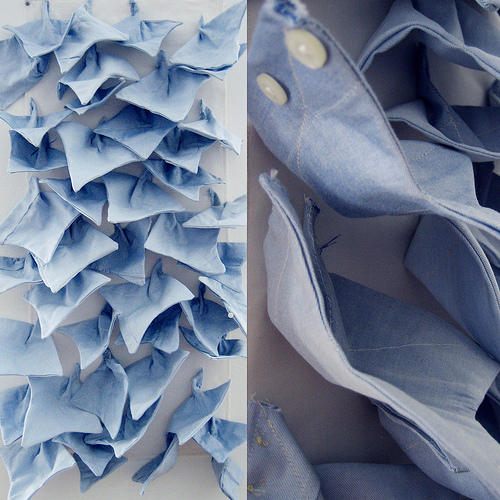
Ivy League Wall
Dimensions: 18”x 36”
Materials: Used blue oxford shirts, muslin, interfacing, thread, hand stitched and machine sewn.
EC: Could you please tell me about your projects for Wave Hill, New York?
LB: This past winter at Wave Hill I developed new felting techniques and quilting techniques for an ongoing textile series, called Topoquilts. The Topoquilts transcribe and transform a landscape into an accoutrement for home living by displaying, through textures and stitching patterns, the topography of a specific landscape. The topography I’m interested in working with are landscapes that have been designed and built as recreational spaces. These are landscapes that have been enhanced as well as domesticated by the control and design of topography, vegetation and accessibility in order to be more easily inhabited by people. A good example of these landscapes can be seen in the work of Frederick Law Olmsted, who was responsible for designing many of America’s well-known urban parks.
I returned to Wave Hill this summer to do a public artwork project—a ceremonial picnic quilt finished during a public quilting bee. The felting volunteers worked with wool roving (lose wool that comes from the sheep) to create textured felt inspired by the surrounding Wave Hill landscape. This felted textile becomes the top fabric for the quilt. Together we traced and then stitched the topographic lines of Wave Hill’s land into the felt. The quilting took on the form of a large public quilting bee over the course of one weekend in mid July. The quilt is on display at Wave Hill until the fall of 2010.
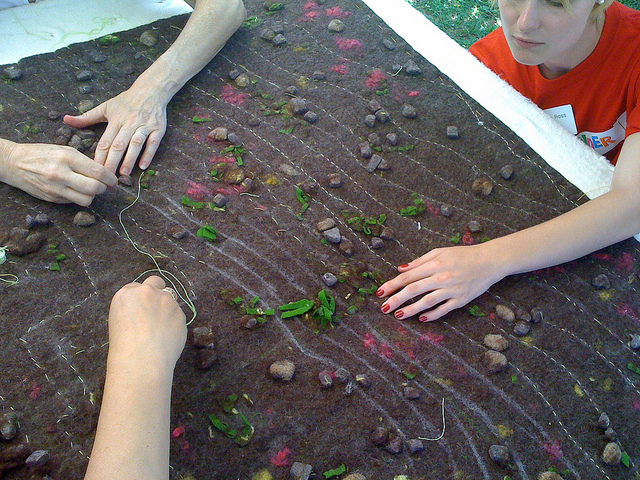
Quilting Bee, Wave Hill Cultural Center, Bronx, NY

Jean Screen
Dimensions: 60″x120″
Materials: Discarded jeans, pvc piping, wood frame
Brooklyn Art Project is currently featuring Liz Burow at the West Elm Store, Brooklyn.




